
Łukasz Białozor
-
Jan 05, 2023
-
4 min read
- 01 . Universal Analytics will be gone on July 1, 2023
- 02 . How to get ready for Google Analytics change
- 03 . Why you should switch to Google Analytics 4 now
- 04 . What is the difference between Universal Analytics (GA3) and Google Analytics 4?
- 05 . Is GA4 missing any features?
- 06 . How to check which Google Analytics you use
- 07 . How can I export data from my Universal Analytics?
- 08 . When will my Universal Analytics property go away?
Google Analytics 4 (GA4) is the next generation of Google Analytics and is set to replace the current analytics tool, Universal Analytics (UA). Let’s dive into the differences between these tools and why you should consider switching to Google Analytics 4 now.
Universal Analytics will be gone on July 1, 2023
On July 1, 2023, Universal Analytics will no longer be available. After this date, if your website or app uses Universal Analytics, you won’t be able to track user data or access new or live analytics reports. However, you’ll still be able to access the already collected data for at least six months.
Universal Analytics will be replaced by a new Google Analytics tool, Google Analytics 4.
Our thoughts? Don’t wait until the last minute to switch to Google Analytics 4. Take control of the transition, and don’t worry – Google wouldn’t leave you to fend for yourself. They prepared resources and tools to make the transition to Google Analytics 4 as smooth as possible.
How to get ready for Google Analytics change
Getting ready for Google Analytics change can be split into three steps:
- Creating a new Google Analytics 4 digital property for your website or app,
- Getting to know Google Analytics 4,
- Comparing data and reports from Universal Analytics and Google Analytics 4.
Create a new GA4 property
To create a new GA4 property, go to the Google Analytics website and search for the “Create Property” button. Click it and fill in the basic information about your website or app, such as name and URL. Now you’re on Google Analytics 4! Once that’s done, enter your data as you have it in your Universal Analytics account to your GA4 account and install the tracking code on your website or app to collect data.
Get to know GA4
If your Google Analytics 4 digital property is ready and you’ve entered the same data as in Universal Analytics, then take time to familiarise yourself with the new tool. Google Analytics 4 offers new features and insights, e.g. cross-device user journeys or AI predictions. Explore the possibilities of the new tool and get a more comprehensive look at your audience.
Compare data and reports from UA and GA4
Now that you have a property on Universal Analytics and a property on Google Analytics 4, you can compare them and see how they differ. It’s not the perfect switch, as you can’t quickly move your data from one service to the other and compare your past data with the present, but it is a great way to set up your GA4 to fit your needs. Explore the differences between GA4 and UA, get a closer look at what they offer, and make GA4 work for you just like you did with UA. And don’t worry if you don’t see all the same features – GA4 is a powerful tool (far more powerful than Universal Analytics). There are some things that you may not see right away (like reports), but you can definitely recreate them in GA4.
Why you should switch to Google Analytics 4 now
Why upgrade to Google Analytics 4 now? It provides more advanced features and insights that will help you understand your audience and user behaviour better. It also offers more integration options with other products from Google, e.g. Google Ads and Google BigQuery. With GA4, you’ll get a more comprehensive picture of your customers and marketing efforts, and you’ll be able to make more informed decisions about your business thanks to their data analysis reports.
We also simply don’t recommend putting off changing from Universal Analytics to Google Analytics 4 — if you manage to do it now, the transition won’t affect you negatively. Tracking user data and accessing analytics reports will go uninterrupted.
If you change from Universal Analytics to Google Analytics4 now, the transition won't affect you negatively.
However, perhaps one of the most important reasons you should switch now is that GA4 is built on a machine-learning platform. This means it will automatically identify and track user behaviour patterns and metrics, and you’ll get more accurate and actionable insights about your customers and user engagement. Waiting just isn’t worth it if you can take advantage of all this data now and see the results in your conversion.
What is the difference between Universal Analytics (GA3) and Google Analytics 4?
So, what are the actual differences between Universal Analytics (GA3) and Google Analytics 4 (GA4)? There are several; however, the most important one is that UA relies on manual tracking code implementation and configuration, while GA4, on the other hand, is built on a machine-learning platform and therefore is more automated (although the code still has to be implemented). This difference will be visible right away as gaining more factual insights about your audience in GA4 won’t require as much manual work. While in Universal Analytics, you had to set up user recognition, GA4 can do it automatically thanks to AI (but you still can adjust it manually to make it work for you).
When it comes to differences visible to the naked eye, Google Analytics 4 and Universal Analytics also differ when it comes to the user interface. If you’re used to having an extensive number of options in your left tab, the left side of your screen will feel pretty empty when you open GA4. The new look is just one of those things that you will need to get used to.
If you already have a property set on GA4 and one in Universal Analytics, then you definitely noticed the difference in reports. They have similar names, but they cover slightly different information. At first glance, it may seem like GA4 gives you less information – don’t worry, that’s not true. GA4 actually collects more data, and you can see it by customising your reports. Customised reports will allow you to choose what data you want to see and provide different reports depending on selected customisation options.
However, Google didn’t stop with customised reports in GA4. They also equipped GA4 with a new option: Explore. This new function enables the users to create their own reports, search the data, and form extra analyses to get even more information from the gathered data. You can select new events there (and certain events, such as scrolling, are already included) and get better, invaluable insight into user engagement.
We’ve already said that GA4 offers integration capabilities with other Google products (for example, and most importantly, Google Ads and Big Query). Nevertheless, it is also important to mention that it provides more data privacy options and a more intuitive interface.
Is GA4 missing any features?
Google Analytics 4 is missing some of the features that were available in Universal Analytics. However, this sentence doesn’t do justice to the complexity of the differences between those two tools.
Let’s start with the features that GA4 definitely doesn’t have – views and filters. In Universal Analytics, you could easily have several views (e.g. separate views for different language versions) based on the filters you chose. In GA4, you can’t set filters and order your data to get better-quality insights. That’s the major downside of the new tool. However, since Google is still working on improving the platform, there’s a chance that views and filters may come back (although it’s doubtful they would do that in 2023; they would’ve announced it by now).
We’ve already covered several differences, such as the change in the user interface, different reports, and exploration reports. If you’re a newbie to analytics, GA4 is a more accessible tool to understand and use. Still, if you’re an experienced analyst with a love for Universal Analytics, you may find it harder to make the change without feeling like you’re missing some features. That’s why it’s important to remember that Google is still working on making its new analytics platform more robust. It’s still in the process of adding more features and expanding its abilities.
How to check which Google Analytics you use
If you don’t know which Google Analytics you’re currently using, you can easily check it by checking the tracking code on your website or app. It’s a snippet of JavaScript that you installed to enable tracking and collecting data.
You’ll find the tracking code in the source code of your website or app. It will most likely be in the header or footer of your website or app.
Once you have your tracking code, it’s a simple check. If your tracking code starts with “UA-” then you’re using Universal Analytics. If it starts with “G-”, you’re using Google Analytics 4.
How can I export data from my Universal Analytics?
Unfortunately, it is impossible right now to export data from Universal Analytics to Google Analytics 4. What you can do, however, is recreate your current property from UA in GA4.
While you can export your data from Universal Analytics, it’s impossible to import them to Google Analytics 4 due to the different nature of the tools. Google Analytics 4 is built as an event-based platform, while UA is based on sessions. It may not sound like a big difference. However, they fundamentally differ when it comes to data architecture, so right now, the only thing to do is understand how these tools differ and how to get the same and more information from GA4.
As do others and Google, we recommend switching to GA4 now and keeping your account in Universal Analytics up to July. If you create a property for your website on GA4, then until July 1, you can compare GA4 to UA and against your past reports from Universal Analytics. This time – from now until Universal Analytics officially goes away – is very precious and will allow you to smoothly switch from one tool to the other. You can see the differences in data, its gathering, and how those tools analyse it. By the time Universal Analytics no longer works, you will be able to fully take advantage of GA4 by creating customised reports, exploring collected data, and adjusting it to give you the same input (and more!) you had using UA.
Of course, if you still want to compare some of the current statistics against your old reports after Universal Analytics is gone, you’ll be able to access them, but it’s hard to tell for how long.
When will my Universal Analytics property go away?
Universal Analytics will become unavailable on July 1, 2023. From then on, it will no longer track audience data, nor will you be able to access the analysis reports. However, you will still be able to access the data you’ve already collected and transfer it to Google Analytics 4 for at least six months after Universal Analytics’ closing.
- 01 . Universal Analytics will be gone on July 1, 2023
- 02 . How to get ready for Google Analytics change
- 03 . Why you should switch to Google Analytics 4 now
- 04 . What is the difference between Universal Analytics (GA3) and Google Analytics 4?
- 05 . Is GA4 missing any features?
- 06 . How to check which Google Analytics you use
- 07 . How can I export data from my Universal Analytics?
- 08 . When will my Universal Analytics property go away?



















